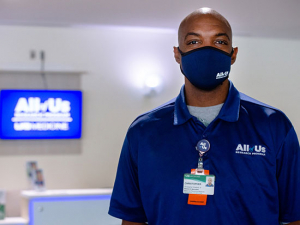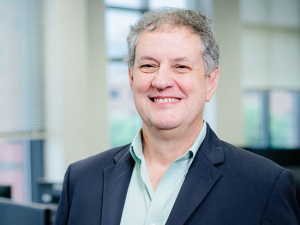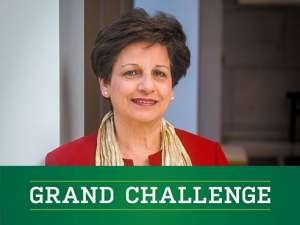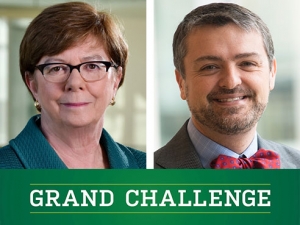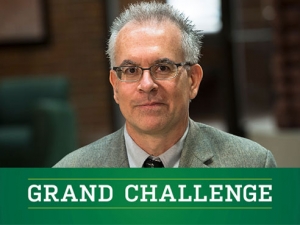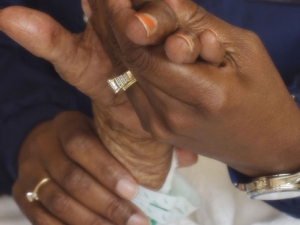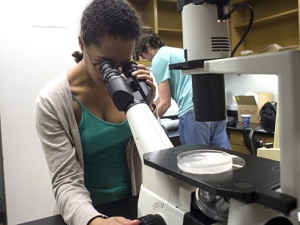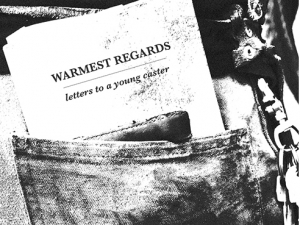 Status epilepticus, a dangerous condition in which epileptic seizures follow one another for a duration of five or more minutes without the victim regaining consciousness between them, is the second most common neurological emergency in the United States, with a recorded maximum of around 150,000-plus cases per year. In 60-70 percent of cases, the patient responds to antiepileptic medications and benzodiazepines.
Status epilepticus, a dangerous condition in which epileptic seizures follow one another for a duration of five or more minutes without the victim regaining consciousness between them, is the second most common neurological emergency in the United States, with a recorded maximum of around 150,000-plus cases per year. In 60-70 percent of cases, the patient responds to antiepileptic medications and benzodiazepines.
But a combination of those medications doesn’t always work, said Wolfgang Muhlhofer, M.D., an assistant professor of neurology in the UAB Epilepsy Center. Up to 44 percent of status epilepticus (SE) cases progress to refractory status epilepticus, where the patient doesn’t respond to those drugs, and more extreme treatments have to be used.
“These emergencies require prompt and effective treatment,” Muhlhofer said. “The longer SE is going on, the higher the chances of brain damage or the body being unable to compensate for the trauma, leading to other complications like cardiac arrest or kidney or heart failure. There’s a lot of risk associated with this condition.”
|
While artificial coma is the agreed-upon treatment for RSE patients, there isn’t an evidence-based consensus on how long patients should be kept in this state. |
Muhlhofer specifically studies patients with refractory status epilepticus (RSE), who are a high risk for complications, death and disability due to their condition. The main treatment for RSE patients is inducing an artificial coma, where the patient is placed on a sedating or anesthetic agent, is intubated and put on a ventilator.
“The idea is to hit the reboot button on the brain, sedating the brain to a stage where there is no seizure activity and the patient is in a deep coma,” Muhlhofer said. “Let the brain get some rest and have some time to reorganize itself.”
Positives and negatives
While artificial coma is the agreed-upon treatment for RSE patients, Muhlhofer said there isn’t an evidence-based consensus on how long patients should be kept in this state.
 Wolfgang Muhlhofer, M.D., assistant professor of neurology in the UAB Epilepsy Center. In 2010, the European Federation of Neurological Societies stated that the recommended coma length is 24 hours when certain medications are given. Yet in 2012, the Neurocritical Care Society Status Epilepticus Committee wrote that “the optimal duration of maintaining electrographic seizure control in patients with RSE is not known since there are few data to indicate what duration of treatment is needed to maintain control.” Most recently in 2016, the American Epilepsy Society said “there is no clear evidence to guide therapy” after a patient has been experiencing RSE symptoms for 40 minutes to an hour.
Wolfgang Muhlhofer, M.D., assistant professor of neurology in the UAB Epilepsy Center. In 2010, the European Federation of Neurological Societies stated that the recommended coma length is 24 hours when certain medications are given. Yet in 2012, the Neurocritical Care Society Status Epilepticus Committee wrote that “the optimal duration of maintaining electrographic seizure control in patients with RSE is not known since there are few data to indicate what duration of treatment is needed to maintain control.” Most recently in 2016, the American Epilepsy Society said “there is no clear evidence to guide therapy” after a patient has been experiencing RSE symptoms for 40 minutes to an hour.
Muhlhofer said recent studies of this patient population have shown that the longer a patient is kept in an artificial coma, the more likely they are to have complications during their hospitalizations — or worse, permanent problems with physical and cognitive functions.
|
“The idea is to hit the reboot button on the brain, sedating the brain to a stage where there is no seizure activity and the patient is in a deep coma.” |
“The question is,” Muhlhofer said, “are we causing more harm than good with this treatment?”
Expanding an idea
Muhlhofer wanted to analyze RSE patients in a more systematic way, with the hopes of determining more specific guidelines regarding the lengths of what he calls
“therapeutic coma.” He designed a study of adult patients, admitted to UAB or University of California, San Francisco (UCSF) Medical Center during a seven-year period, who were placed in an artificial coma and who had a seizure recurrence within the first 48 hours of lightening the patient’s sedative medications.
Particularly of interest to Muhlhofer, who developed this idea about three years ago while a fellow at UCSF, are complications patients experience as a result of artificial coma, such as urinary tract infections, hospital-acquired or ventilator-associated pneumonia, deep vein thrombosis or pulmonary embolism and strokes, among others. He also is studying whether the patient was discharged with a disability or need for physical rehabilitation or long-term care.
Muhlhofer had a small patient population gathered from his time at UCSF, but it was too small for the study. But UAB — “a large tertiary care center with lots of referrals and a big patient population” — is the “ideal fertile ground to recruit additional patients,” Muhlhofer said.
He began with 42 patients from UCSF that fit his criteria. He then worked with the UAB Center for Clinical and Translational Science’s (CCTS) Enterprise Data Warehouses to add about 100 more patients. When Muhlhofer paired those two collections with UAB’s access to i2b2, a self-service application that enables UAB researchers to access de-identified patient data, he was able to double his sample size.
|
“[i2b2] is a very intuitive way of using different filters and criteria to narrow down a patient population, especially for creating preliminary data sets for applications.” |
A new standard
Muhlhofer plans to use the preliminary data he’s gathering to apply for grants that will enable him conduct a randomized clinical trial to look at different durations of therapeutic coma and take a specific look at health outcomes, primarily sustained seizure control.
“Do patients slip back into seizing the moment you take away the medications? The second question is if there are issues during the hospital stay. Are there any complications right after their discharge? Up to a year after?” Muhlhofer asked, adding that the answers to these questions could help solidify clinical standards for what the best treatment plans are for RSE patients.
“Hopefully this is the springboard to something bigger,” he said, “and to clarifying questions on a topic that’s very controversial in the field right now.”
This preliminary analysis, which i2b2 helped him create, gave Muhlhofer a better idea of potential sample sizes and how to calculate sample size for future study proposals. His goal is eventually to have a multi-centered clinical trial across the United States.
Muhlhofer isn’t the only researcher who’s used i2b2 to further his research substantially. Morgan Dew, a nurse at Children’s of Alabama, used it to nearly double her sample size when researching instances of pregnancies in women born with spina bifida, and Abdullah Alanazi, a Ph.D. student in rehabilitation science who used it to find data comparing smokers’ uses of electronic cigarettes and tobacco, was the winner of the inaugural i2b2 Abstract Awards Contest held earlier this year. Muhlhofer, Dew and Alanazi presented their research in the Center for Clinical and Translational Science’s April forum; view the 45-minute presentation on YouTube.
|
Any researcher at UAB can access i2b2; CCTS offers online i2b2 training videos and step-by-step instructions for accessing the system to obtain summary and detailed data sets. |
Any researcher at UAB can access i2b2; CCTS offers online i2b2 training videos and step-by-step instructions for accessing the system to obtain summary and detailed data sets.
“I think it’s a very intuitive way of using different filters and criteria to narrow down a patient population, especially for creating preliminary data sets for applications,” Muhlhofer said. “It’s an excellent tool, and they’re also continuously developing it, improving it and making it more user-friendly, trying to simplify it and make it more intuitive. I think i2b2 will continue to be a very beneficial tool.”






